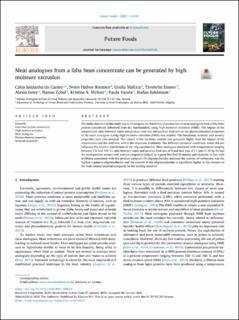Meat analogues from a faba bean concentrate can be generated by high moisture extrusion
do Carmo, Cátia Saldanha; Knutsen, Svein Halvor; Malizia, Giulia Sofia; Tzvetelin, Dessev; Geny, Alexia; Zobel, Hanne; Myhrer, Kristine S.; Varela, Paula; Sahlstrøm, Stefan
Journal article
Published version
Permanent lenke
https://hdl.handle.net/11250/2736136Utgivelsesdato
2021Metadata
Vis full innførselSamlinger
- Artikler / Articles [1449]
- Publikasjoner fra CRIStin [2518]
Originalversjon
10.1016/j.fufo.2021.100014Sammendrag
The main objective of this study was to investigate the feasibility of production of meat analogues from a faba bean protein concentrate (obtained from dry fractionation) using high-moisture extrusion (HME). The impact of the temperature, ratio between water and product feed rate and product feed rate on the physicochemical properties of the meat analogues during high-moisture extrusion (HME) was studied. The functional, textural, and sensory properties were also assessed. The impact of the moisture content was generally higher than the impact of the temperature and the feed rate within the responses evaluated. The different extrusion conditions tested did not influence the relative distribution of the oligosaccharides. Meat analogues produced with temperatures ranging between 130 and 140 °C, ratio between water and product feed rate of 4 and feed rate of 11 rpm (1.10 Kg/h) had the most positive sensory and textural properties judged by a good bite-feel (firmness) and elasticity in line with attributes associated with this product category. Of oligosaccharides analysed the content of verbascose was the highest -galacto-oligossacharide and the content of the oligosaccharides is significant higher in the extracts of the heat-treated material compared to the starting material.
